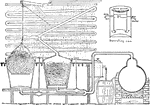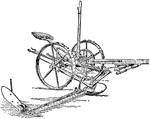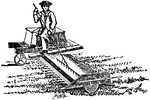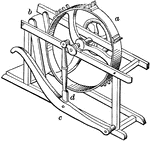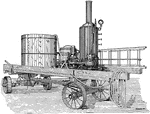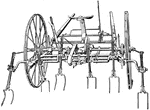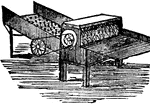The Agricultural Machines ClipArt gallery offers 187 illustrations of reapers, spreaders, cultivators, and other equipment used in agriculture.
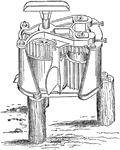
Vertical Cane Mill
"The accompanying engraving is an illustration of a new style vertical mill in which an attempt is made…
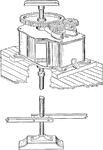
Vertical Cane Mill
"To avoid the inconvenience of having the team travel around the mill, interfering with the passing…

Modern Flour Mill
This illustration shows a cross-section of a modern flour mill. Wheat is received in bin a, and first…

Paris Green Sifter
Paris green was used as a popular pigment in artist's paints because of the brilliance of the green.…
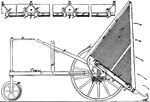
Peteler locust crushing machine
The Peteler locust crushing machine was a horse drawn device used to trap and kill locusts. Locusts…

Corn Planter
This corn planter featured an adjustable dropping device. This allowed the operator to drop the corn…

Plow
A tool used in farming for initial cultivation of soil in preparation for sowing seed or planting.

Cultivation Plow
The plow is a tool used in farming for initial cultivation of soil in reparation for sowing seed or…
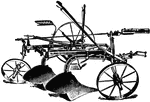
Four-Horse Gang Plow
A four-horse gang plow. One man can plow nearly as fast as two ment with two-horse plows.
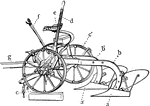
Gang Plow
Two or more plows attached to a stock or frame. Generally having wheels as a sulky plow has, with adjustable…

Motile Plow
A farm tool having one or more heavy blades to break the soil and cut a furrow prior to sowing

Portable Threshing-Machine
A machine invented by Andrew Meikle to seperate grain from stalks and husks.
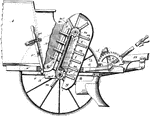
Potato Planter
This potato planter is a cup type planter for autonomous planing or graded seed potatoes. It plants…

Centrifugal Pump
"Some forms of centrifugal pump, however, have been designed for use with horse power and even for windmills."—Government…

Riley Locust-Catcher
One of the best known machines of its type, the Riley Locust-Catcher was employed to exterminate mass…

A Roman Farmer with a Plow
Illustration of a Roman farmer driving his plow, called an aratrum. The man wears a typical brimmed…

Scutcher
"Scutching-machine or Scutcher for Flax. a, feed-table on which the flax is fed to the fluted rollers…

Power Cream Separator
A cream separator is device invented by Martin Wiberg to separate cream from milk (see also Gustaf de…

Corn Sheller
This corn sheller design allowed corn to dropped to a hopper which was then carried using the rotational…
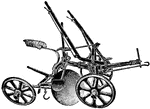
Single Disc Plow
The disc plow is the result of an attempt to reduce plowing draft due to sliding friction.

Combined Disk Harrow, Sod Cutter, and Roller
the Sod Cutter is also known as the shave off technique, shovels, hoes, or similar machinery are used…
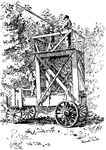
Square Tower
Illustrated is a square tower used for spraying insecticide. It gives more working space for the nozzle-men…

Steam Apparatus
Side view of a steam apparatus constructed by Stephen Hoyt's Sons, New Canaan, Conn.

Steam plow
A Steam plow, 1901. The travel of the plows is at right angles to the travel of the engine.
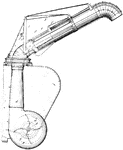
Straw Stacker
A straw stacker features the combination of a centrifugal discharger, of a feeding device comprising…
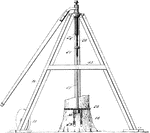
Stump Puller
Stump pullers are the primitive method of extracting stumps. This method is to hitch on a yoke of oxen,…

The Anderson Coal-oil Contrivance.
The Anderson Coal-oil Contrivance was a simple and effective locust extermination device. A flat pan…

The Flory-Locust Machine
The Flory-locust machine was a horse-drawn implement used by farmers to exterminate locust populations.…

The Mule
"Probably no inventive contribution has been offered to the cotton trade more important than the mule.…

The Price Oil-Pan
The Price pan was a simple and effective locust extermination device. A flat pan was filled with coal…

Two Wheeled Tobacco Planter
Various tobacco planters were invented in the nineteenth and twentieth centuries. The tobacco planters…

Tobacco Seed Blower
Tobacco seed blower for planting tobacco seed. Tobacco seed is so small that it takes about 5 million…

Buckeye Mower
The Buckeye mower was manufactured between 1875 and 1899 by Buckeye Mower and Reaper Co. Considered…

Carpenter's Improved Horse-rake
Horse-rakes are on a footing different from mowing machines. Grass may be cut in the morning, in the…
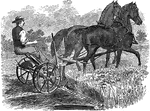
Wood Mower
The Walter A. Wood Mowing and Reaping Machine Co. manufactured this reaper. By 1860 he had an improved…
